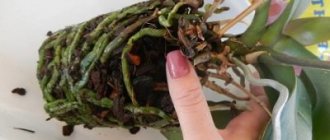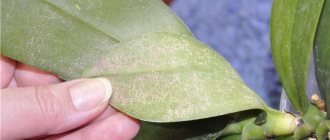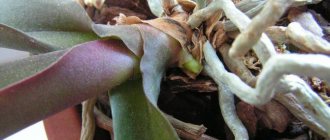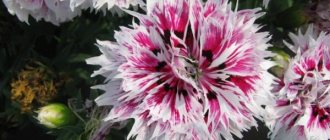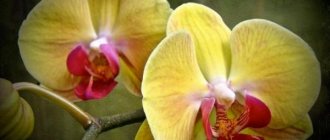White orchids are flowers that were first discovered in Indonesia and Southern China. Today the plant can be found on the plains and in tropical forests, as well as on the windowsills of most orchid lovers. Phalaenopsis has captivated flower growers so much that they do everything possible to keep the flower blooming and developing.
Considering that the presented species of orchids blooms regardless of the time of year, you can enjoy snow-white blooms almost all year round. With proper care, the plant will bloom for more than 6 months a year.
What is it like: home care
Many gardeners worry that care at home will require a lot of effort and time. Although this is not at all true.
Breeders bred the white phalaenopsis orchid just for home cultivation. Therefore, you don’t need to worry about the temperature in the room being unsuitable or having to constantly worry about air humidity. But it has not yet been possible to breed a completely black orchid, although there are some species that are very close to this color.
All care usually comes down to the following points:
- landing;
- lighting;
- watering;
- feeding;
- soil;
- pruning and replanting.
By adhering to some rules, it will be possible not only to grow white orchids, but also to propagate them.
Landing
It is recommended to plant a white orchid in a transparent pot. You need to pay attention to the fact that there are small holes at the bottom for aeration. Before planting the flower, drainage must be poured onto the bottom. Beginning flower growers are recommended to buy a special substrate in stores. Those who already have experience growing similar flowers can prepare the soil themselves. To do this, you will need to take dry bark, a little sphagnum moss and charcoal.
Lighting
Without light, the orchid will die, so it needs to be provided with good lighting. In the summer, a flowerpot with a flower can be placed relatively close to the window. However, you need to make sure that the plant is not exposed to direct sunlight all day. In winter, you may need an additional light source, such as a fluorescent lamp.
Despite the fact that phalaenopsis takes root well at any temperature, it is best that it is within +20..+23°C. A mark below +15 °C is quite alarming; at low temperatures the plant may even die.
Watering
The white orchid does not require frequent spraying or watering. As soon as it has been noticed that the tree bark (and this is the main part of the substrate) has dried well, manipulation can begin. In hot weather, the flower is usually watered a couple of times a week, and in winter, when the room is cool enough, the procedure can be carried out no more than three times a month.
Important! During flowering, the flower is watered from a watering can and is not moved from place to place.
Only clean water should be used. There can be no talk of any liquid from the tap. Considering that some apartments are very hot in winter, the plant may not have enough air humidity. In order to provide it to the flower, you should spray the phalaenopsis with a spray bottle or place a jar of water nearby.
Top dressing
There is no need to rush to fertilize the flower immediately after it was purchased . Fertilizers are applied only after a couple of years. They are sold in flower shops. Moreover, a non-blooming orchid is fertilized once a month, but a flowering orchid is fertilized 2-3 times a month.
The soil
Most gardeners buy ready-made substrate in stores. In principle, this is a good idea, since it practically eliminates the possibility of various pests getting into the flower with the soil. Although, if you do everything correctly, you can make your own soil mixture.
To do this you need to take:
- tree bark (4 parts);
- sphagnum moss (1 part);
- charcoal (1 part).
And mix it all well. The bark must be well dried and pre-boiled to prevent pests from entering the soil. It is also necessary to ensure that all components are neither large nor small in size. Because in the first case the substrate will be very large, and in the second it will resemble dust.
External characteristics of Phalaenopsis Amabilis
"Amabilis" is the progenitor of many hybrids growing in nature. It can be found in Borneo, Ambon, Australia, northern Philippines, New Guinea, Java and the Celebes Islands.
Mature plant height
The plant itself is a monopodial epiphyte, stem size from 10 cm to 50 cm , with 4-5 double-rowed, long, elliptical, fleshy leaves.
Phalaenopsis amabilis.
Maximum peduncle length
The flower stalks of an adult plant can reach a meter in length. Depending on the growing conditions, they have an average height of 60 to 90 cm.
It often produces a pair of fairly branched, arched, purple-colored flower stalks at once.
Flower diameter
Typically, 15 flowers develop simultaneously on a peduncle, but an adult plant can bear up to 70 fragrant flowers at the same time.
Their diameter on average ranges from 7 to 9 cm . There are specimens whose diameter can be up to 12-13 cm.
The wide petals and sepals look impressive, having a milky white color with a hint of pink on the outside.
How does a white orchid reproduce?
White phalaenopsis is quite difficult to breed. The interesting thing is that even experienced gardeners sometimes cannot do this.
However, everyone should know how the procedure is carried out in order to have at least some idea about it.
So, reproduction occurs:
- By dividing the stem (usually this method is used to rejuvenate the flower).
- Children. They appear on the peduncle. This happens rarely, but it does happen.
- By seating. If several rosettes with separate roots appear, then you should not hesitate, but plant them in separate flowerpots.
List of varieties with name and photo
There are flowers of different colors in the genus (yellow, pink, purple, blue and even black), but this article deals with white orchids. There are several interesting varieties that differ in this color. Next, you can read the description and look at the photos of the varieties.
Amabilis or Phalaenopsis Pleasant
This variety can be called classic ; it is often used to give rise to other hybrids. The plant has a long, bent peduncle with branches; the number of large white flowers on it can reach 20, they open one by one.
Orchid lips have a solid light yellow or golden color, and there are also examples with small dark pink splashes. A faint pleasant aroma emanates from the flowers.
Photo of this variety:
Parisha
This miniature version is interesting because it has several short pedicels, small flowers, but large and wide leaves . The color of the flowers is darker than snow-white, each of them has a large purple lip. Up to 10 inflorescences are formed on each peduncle. Parisha has a pleasant fruity aroma.
This is what the Parisha variety looks like:
Phalaenopsis philippines
Under natural conditions, this plant grows in the mountains, has dark green leaves with silvery notes and a long peduncle hanging under the weight of medium-sized white flowers, which open simultaneously in quantities of up to 50 pieces. They have small yellow spots with pink splashes. In the house, flowers are not so large.
In the photo - Phalaenopsis Philippine:
Mini Mark
This decorative version of the orchid, compared to other varieties, has a very funny appearance , which makes the atmosphere in the house more pleasant. Several low flower stalks hold small white flowers with pink flecks on each petal and a bright orange lip in the middle acting as the highlight.
Photo of the Mini Mark variety:
Pests and diseases of flowers
Often the plant is affected by various types of rot. This is due to an incorrect watering scheme. Fearing that the flower will dry out, flower growers begin to carry out uncontrolled irrigation or “soaking”. Of course, this leads to excessive soil moisture and root rotting. In order to eliminate this, you need to forget about watering for a while (for a couple of weeks), and then proceed according to the scheme.
If this does not help or the root system is already very rotten, then you cannot do without special means (such as phytosporin-M, for example).
Pests, if they do not bypass the white orchid, then attack it extremely rarely. You also need to fight parasites using special solutions.
Variety of varieties
Although white is one of the most popular colors among gardeners, pure white is extremely rare. Basically, it has some color splashes or a different colored edging.
It is believed that the “Amabilis” variety became the progenitor of many varieties and hybrids of this orchid variety. It is impossible to list all the hybrid varieties due to their diversity, but the most popular are:
- "Adelaide"
- "Alabaster";
- "Alaska"
- "Bristol"
- "Cotton Candy";
- "Anthyra Darwin";
- "Christa Wichmann";
- "Cristella"
- "Diamond"
- "Formosa Dream";
- "Gold Lip";
- "Island"
- "Japanese Heart"
- "Kiska"
- "Malibu Chablis";
- "Madonna"
- "Memories"
- "Misty Mountain"
- "Polar Bear"
- "Prima Piano"
- "Ragen"
- "Salt Lake"
- "Samoa"
- "Soft Cloud" etc.
They can have different flower sizes - from large (Royal) to small (mini Mark). The size of the plant itself is also varied, from mini to 1 m.
Problems when growing orchids
The white phalaenopsis orchid is unpretentious, but this does not mean that you can not care for it. If everything is done correctly, then nothing bad will happen to the plant. Problems are usually signaled by a long absence of flowering, yellowing of leaf blades, cracks in the leaves and even their falling off. In the case where this was noticed, certain reasons that could lead to this should be excluded or confirmed.
By properly caring for the flower, the white orchid will become a real decoration for your room or office space.
Features of these plants
To understand the characteristics of this flower, you need to know the conditions in which it grows in the wild. The phalaenopsis orchid comes from tropical forests, where the air temperature is 19-27 °C and the air humidity is very high.
Phalaenopsis is an epiphytic plant. That is, it grows on trees and stumps.
Tenacious aerial roots wrap around tree branches and serve as a support for the plant, clinging to which the phalaenopsis rises towards the light in the shady tropical forest. An orchid is not a parasite and does not cause any harm to the tree on which it grows.
Some white orchids reach a height of 1 m. There are also very miniature plants, the height of which does not exceed 30 cm.
In nature, the phalaenopsis orchid can bloom all year round. The number of buds depends on the condition of the plant and its size. Each flower lives up to three months! The total lifespan of the plant is about ten years. White phalaenopsis flowers have virtually no scent.


